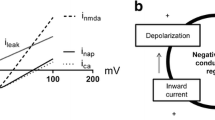Summary
The passive electrical cable properties of ocellar L-neurons were determined by applying current steps and recording the voltage transients using a two-electrode intracellular current clamp system. Morphological data were obtained following intracellular staining with Lucifer yellow.
Two groups of neurons were distinguished physiologically. In the first group both the membrane time constantτ m and the first equalizing time constantτ 1 could be determined. In the second group onlyτ m was measurable. The ratio of the physiological groups was equal to the ratio of the morphological types ML:(M1 plus M2) in the median ocellar nerve. Thus the first group probably consists of ML-type L-neurons. The passive cable properties of this group were calculated by combining the physiological and morphological data. The following values were obtained: electrotonic lengthL=1.35; membrane time constantτ m =7.6 ms; length constant λ=0.22 cm; membrane resistivityR m=2.0 · 103 Ω · cm2; membrane capacitanceC m=3.8 μF · cm−2; intracellular resistivityR i=24Ω · cm. Evidence is presented that the membrane parameters of the other types of L-neurons have the same values. The results are discussed with special reference to transmission in the ocellar system.
Similar content being viewed by others
References
Ammermüller J (1984) Membraneigenschaften nichtspikender L-neurone im Ocellusnerv vonLocusta migratoria L. Dissertation, Fakultät für Biologie, Universität München, München
Ammermüller J, Weiler R (1985) S-neurons and not L-neurons are the source of GABAergic action in the ocellar retina. J Comp Physiol A 157:779–788
Fox CH, Johnson FB, Whiting J, Roller PP (1985) Formaldehyde fixation. J Histochem Cytochem 33:845–853
Goodman CS (1974) Anatomy of locust ocellar interneurons: Constancy and variability. J Comp Physiol 95:185–201
Goodman CS (1976) Anatomy of the ocellar interneurons of acridid grasshoppers. II. The large interneurons. Cell Tissue Res 175:183–202
Goodman LJ (1981) Organization and physiology of the insect dorsal ocellar system. In: Autrum H (ed) Vision in invertebrates (Handbook of sensory physiology, vol VII/6C). Springer, Berlin Heidelberg New York, pp 201–286
Goodman LJ, Mobbs PG, Guy RG (1976) Information processing along the course of a visual interneuron. Experientia 33:748–750
Järvilehto M, Zettler F (1971) Localized intracellular potentials from pre- and postsynaptic components in the external plexiform layer of an insect retina. J Comp Physiol 75:422–440
Kaneko A (1970) Physiological and morphological identification of horizontal, bipolar and amacrine cells in the goldfish retina. J Physiol 207:623–633
Kaneko A, Tachibana M (1985) A voltage-clamp analysis of membrane currents in solitary bipolar cells dissociated fromCarassius auratus. J Physiol 358:131–152
Oertel D, Stuart AE (1981) Transformation of signals by interneurones in the barnacle's visual pathway. J Physiol 311:127–146
Pichon Y, Ashcroft FM (1985) Nerve and muscle: electrical activity. In: Kerkut GA, Gilbert LI (eds) Nervous system: Structure and motor function (Comprehensive insect physiology, vol V). Pergamon Press, Oxford New York Toronto Sidney Paris Frankfurt, pp 85–113
Rall W (1969) Time constants and electrotonic length of membrane cylinders and neurons. Biophys J 9:1483–1508
Rall W (1977) Core conductor theory and cable properties of neurons. In: Kandel ER (ed) The nervous system: Cellular biology of neurons (Handbook of physiology sect I, part I, vol I). Am Physiol Soc, Bethesda, pp 39–98
Simmons PJ (1981) Synaptic transmission between secondorder neurones of a locust ocellus. J Comp Physiol 145:265–275
Simmons PJ (1982a) Transmission mediated with and without spikes at connexions between large second-order neurons of locust ocelli. J Comp Physiol 147:401–414
Simmons PJ (1982b) The operation of connexions between photoreceptors and large second-order neurones in dragonfly ocelli. J Comp Physiol 149:389–398
Stuart AE (1983) Vision in barnacles. TINS 6:137–140
Taylor CP (1981) Graded interactions between identified neurons from the simple eyes of an insect. Brain Res 215:382–387
Weidmann S (1952) The electrical constants of purkinje fibres. J Physiol 118:348–360
Weiler R, Zettler F (1976) Electrophysiological and histological studies of the carp retina. In: Zettler F, Weiler R (eds) Neural principles in vision. Springer, Berlin Heidelberg New York, pp 111–120
Wilson M (1978) Generation of graded potential signals in the second order cells of locust ocellus. J Comp Physiol 124:317–331
Author information
Authors and Affiliations
Rights and permissions
About this article
Cite this article
Ammermüller, J. Passive cable properties of locust ocellar L-neurons. J. Comp. Physiol. 158, 339–344 (1986). https://doi.org/10.1007/BF00603617
Accepted:
Issue Date:
DOI: https://doi.org/10.1007/BF00603617




